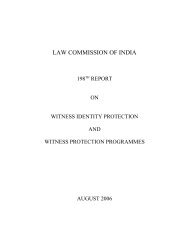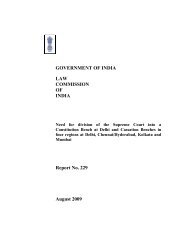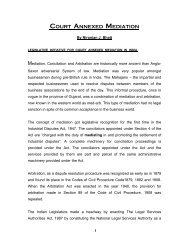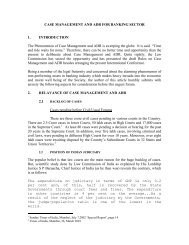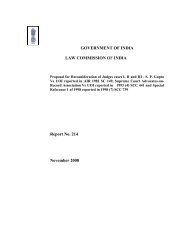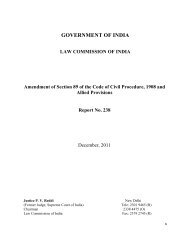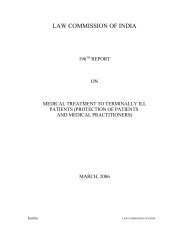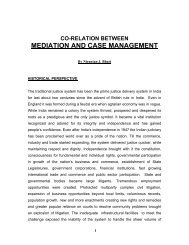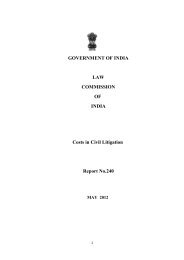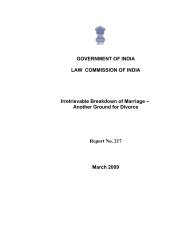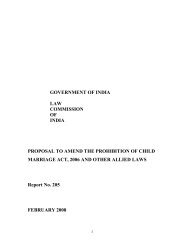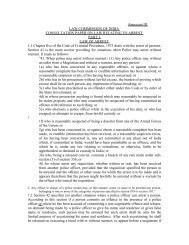MEDIATING MEDIATION REFORM IN INDIA - Law Commission of ...
MEDIATING MEDIATION REFORM IN INDIA - Law Commission of ...
MEDIATING MEDIATION REFORM IN INDIA - Law Commission of ...
You also want an ePaper? Increase the reach of your titles
YUMPU automatically turns print PDFs into web optimized ePapers that Google loves.
II.<strong>MEDIATION</strong>: TOOLS AND VALUESA. The Global ContextMany national legal systems have made sweeping commitments to three areas <strong>of</strong>substantive political and economic reform. First, traditionally authoritarian politicalsystems have sought to achieve greater democracy through popular elections, moreaccountable and transparent public service, and the effectuation <strong>of</strong> domestic humanrights protections. Second, governments have loosened their grips on economicsystems, embraced a freer marketplace, and recognized a broader range <strong>of</strong> real andintellectual property rights. Third, the international community has embarked on anearly uncontrollable and irreversible process <strong>of</strong> globalization. Unprecedented dailyflows <strong>of</strong> capital, technology, goods, services, information, and people currentlypermeate national borders. In pursuit <strong>of</strong> these commitments (democracy and humanrights; free, knowledge-based economies; globalization and the reduction <strong>of</strong> crossnationalbarriers), countries have generated an enormous amount <strong>of</strong> new substantivelaw, including civil rights, criminal justice reform, commercial legislation, constitutionallaw, and free trade agreements and regional economic unions.Courts and supporting public and private institutions are increasingly considered criticalto the implementation <strong>of</strong> legal reform in pursuit <strong>of</strong> widely shared 21 st centuryobjectives. No branch <strong>of</strong> government is better designed to hold political and economicactors accountable to law, or to ensure commercial and property rights and obligationsare enforced through impartial judgment. To perform this role, however, courts (orsome functional equivalent to them) must be independent from undue politicalinterference, maintain integrity in the face <strong>of</strong> private financial pressures, and operate ata high level <strong>of</strong> efficiency, especially given frequently inadequate allocations <strong>of</strong> humanand financial resources. As Amartya Sen has emphasized in a broader context, “[o]uropportunities and prospects depend crucially on what institutions exist and how theyfunction.” 5The judiciary may be the least dangerous branch <strong>of</strong> government, but sadly it is also themost neglected. Courts are fragile political institutions, and more resilient political,economic, and cultural forces easily undermine their effectiveness. Judiciaries areunderfunded, undersupported, undertrained, and underprotected. National judicialsystems have not been able to keep pace with substantive commitments to democracy,free markets, and globalization. Political and economic interference with impartialityand delay in the administration <strong>of</strong> justice currently undermine the achievement <strong>of</strong> coreobjectives in many countries. An excessively partial or slow process rendersobservations and limited expertise both beyond and within India. Please submit comments, questions,and criticisms to me at hiram.chodosh@cwru.edu.5 See AMARTYA SEN, FREEDOM AS DEVELOPMENT 142 (1999).3
fundamental public legal principles ineffectual, eviscerates private legal rights andobligations, cultivates conditions conducive to corruption, and favors the powerful overthe weak. These common institutional problems undermine equality under the law andcorrode the incentives critical to legal compliance.The growing importance <strong>of</strong> recently implemented law has also imposed new burdens oncourts. New rights create new forms <strong>of</strong> legally cognizable claims and disputes. In mostmarket-oriented or democratic countries, case filings are on the rise; yet, mostcountries are not close to keeping pace. India is far from alone on this single index: inmany countries from Latin America to Eastern Europe case filings (roughly) doubledover a single decade. Notwithstanding the common need for institutional reform, thesebacklogs occur not only because the courts do not have the institutional resources toshoulder these new burdens, but also because the society has heightened expectations<strong>of</strong> getting justice from the courts.In light <strong>of</strong> this global challenge to national court systems, what promise, if any, doesmediation <strong>of</strong>fer? Does mediation, as one particular form or cluster <strong>of</strong> attributes thatdiffer from features <strong>of</strong> European-originating court systems, <strong>of</strong>fer even a partial solutionto meet these pressing burdens?B. Initial Attraction to MediationMediation is no panacea, no magic solution to overcome the institutional challenges <strong>of</strong>national court systems. Similar to other alternative dispute resolution techniques,however, it does <strong>of</strong>fer a cluster <strong>of</strong> features that differ from the formal judicial systems<strong>of</strong> Europe that have had global influence over the primary ways in which legal conflictsare resolved. In this regard, mediation both builds and diversifies the capacity forresolving conflicts in society. With many qualifications and exceptions, European-stylecourts (both common law, Anglo-Saxon, and their continental European, civil lawcounterparts) are state institutions, conducting public, formal proceedings, thatpresuppose literacy, posture the parties in a conflictual, legal position-based, backwardlookingfact finding processes that result in binary, win-lose remedies, subsequentlyenforced through social control over the losing party. In contrast, mediation (and otherclusters <strong>of</strong> consensual dispute resolution techniques, except for arbitration) are private,informal, oral, more collaborative, facilitative, future-looking, interest-based processesthat bring parties to a calibrated, multi-dimensional, win-win remedy that is moredurable because <strong>of</strong> the parties consent in the outcome.Because <strong>of</strong> these basic contrasting features, for many non-European legal cultures,mediation bears a comforting alternative and similarity to traditional forms <strong>of</strong> disputeresolution that predate colonial influence. Reformers have grown increasinglyinterested in reviving or extending traditional forms <strong>of</strong> dispute resolution (such as theprocess <strong>of</strong> sulha in the Middle East or methods used by the traditional panchayats inIndia) and integrating them into the formal litigation system (the distinctive form <strong>of</strong>4
evaluative Chinese mediation known as tiaojie). Egypt, for example, now requiresmediation before a retired judge in each case brought by private parties against thegovernment. 6Throughout Europe, mediation is seen as a potentially promising mechanism for theresolution <strong>of</strong> both simple and complex disputes. Norway's conciliation boards(Forliksradene) provide a model <strong>of</strong> extensive comparative interest and internationalstudy. In 1995, France expanded the legislative basis for judicial conciliation andmediation. Diverse countries from Tanzania to the Ukraine are pursuing mediationreforms as a response to contemporary demands. In many <strong>of</strong> these jurisdictions,mediation is seen as useful not only for small claims, auto accidents, family disputesand petty crimes in court systems clogged by a modern docket, but also as analternative dispute resolution device for the most complex matters, including thoseinvolving environmental (e.g., water rights) and intellectual property law disputes (e.g.,patents) previously considered to be irreconcilable. The speed <strong>of</strong> change in strongnational and emerging global markets puts increasing pressure on large businessinterests to resolve disputes quickly and inexpensively, as well as amicably,constructively and creatively, in order to maximize long-term interests and to maintainongoing commercial relationships.Effective forms <strong>of</strong> mediation at the local level may also provide a strong foundation forthe resolution <strong>of</strong> cross-border armed conflict. When direct negotiations fail,communities that seek to resolve pr<strong>of</strong>ound intra- and inter-border conflicts areincreasingly turning to neutral third parties from countries with well-developedmediation practices. 7 This invaluable service, however, is <strong>of</strong>ten too late or too remotefrom the community level to nip the budding emergence <strong>of</strong> these conflicts. Thus, thedevelopment <strong>of</strong> a more proximate, indigenous mediation capacity may help to preventdeeply rooted conflicts from erupting into communal violence. 8The application <strong>of</strong> mediation to the legal dispute resolution process is not intended toreplace or supplant the need for public adjudication and normative judicialpronouncements on the critical issues <strong>of</strong> the day, but to complement and preserve that6 See Hiram E. Chodosh, Stephen A. Mayo, Fathi Naguib, & Ali El Sadek, Egyptian Civil Justice ProcessModernization: A Functional and Systemic Approach, 17 MICH. J. <strong>IN</strong>T’L L. 865, 895 (1996). This studyconducted by the Institute for the Study and Development <strong>of</strong> Legal Systems led to new legislationrequiring suits against the government to be mediated by retired judges. See <strong>Law</strong> No. 7/2000,Concerning The Establishment Of Conciliation Committees In Certain Litigations To Which The MinistriesAnd Juridical Persons Are Parties (Egypt).7 These neutrals may be prominent foreign political leaders or diplomats, e.g., former U.S. SenatorGeorge Mitchell in Northern Ireland or the Norwegian diplomat Terje Roed-Larsen in the Middle East.8 See Hiram E. Chodosh, Local Mediation Capacity in Advance <strong>of</strong> Armed Conflict, 19 OHIO STATE JOURNALON DISPUTE RESOLUTION __ (forthcoming 2003).5
core normative purpose <strong>of</strong> the judicial system. Indeed, self-standing mediation reforms<strong>of</strong>ten collapse for failure to grasp the necessarily integral relationship between courtsand the alternatives. As will be discussed further below, mediation reform and othermeasures to improve court and case management must go hand in hand.In particular, mediation may serve to relieve some <strong>of</strong> the pressures currently impedingthe performance <strong>of</strong> European-style court systems. First, mediation may have a modesteffect on political interference with the courts. By placing control for the resolution <strong>of</strong>disputes in the hands <strong>of</strong> the parties, the state has less power to interfere with theresolution <strong>of</strong> private disputes, and by relieving the burden <strong>of</strong> the courts, the politicalbranches may be less able to debilitate the courts through neglect, e.g., paltry publicinvestments in their institutional well-being. Second, mediation reduces the incentivesfor corruption because the neutral third-party has no authority to bind the parties to anoutcome <strong>of</strong> his or her choosing. This lack <strong>of</strong> power over the parties (and a lack <strong>of</strong>monopoly over dispute resolution by the courts more generally) means that <strong>of</strong>ficialshave greater difficulty extracting rents from litigants through coercive means. Finally,putting aside the more controversial role <strong>of</strong> plea-bargaining in criminal procedure,mediation is utilized in attempts to reduce court backlogs and delays. The search fordocket clearing devices present the first source <strong>of</strong> motivation for exploring mediationreforms; however, the relationship between mediation and court delays is morecomplex than either detractors or supporters like to admit. The most valuablecontribution <strong>of</strong> mediation to the society may actually lie elsewhere (e.g., in theinternalization <strong>of</strong> the communication and negotiation techniques within the legalprocess and broader society).The use <strong>of</strong> mediation as a solution to court backlogs thus merits a more thoroughexplanation.Imagine the legal system in the metaphor <strong>of</strong> a funnel designed to sift through small andlarge stones in an effort to produce precious gems. If I pour stones into the widemouth <strong>of</strong> the funnel at the top, the system will process them through a narrow channel,producing the gems through the narrow mouth at the bottom. Let’s assume that thestones en masse represent all <strong>of</strong> the legally cognizable disputes in society, and thegems that come through the narrow neck represent judicial decisions as the articulation<strong>of</strong> public norms that then guide the society in its public and private behavior. Let’sfurther assume that the purpose <strong>of</strong> the funnel is to find and process the gems, not (byitself) to resolve every single dispute in the society.Now let’s imagine that, because <strong>of</strong> the sheer scale <strong>of</strong> the number <strong>of</strong> disputes in societyand the unchanged, narrow neck <strong>of</strong> the funnel, the stones (and even smaller jewels)are creating a bottleneck, and too many disputes put into the funnel are not allowingthe valuable ones, (those worth the public investment <strong>of</strong> the courts), to pass throughthe system efficiently.6
Generally, legal systems apply three strategies to this bottleneck. First, they try toprevent more stones from entering the funnel, but here they <strong>of</strong>ten try to do this byimposing increases in court costs or creating other incentives (cost shifting) to preventclaims from entering the system. Such prevention measures (court costs in particular--the cause <strong>of</strong> current disturbances by the bar in Gujarat) are crude and unjust tools forpreventing backlogs: crude, because they do not contemplate that cases <strong>of</strong> greatnormative value may never get to the courts because the claimant cannot afford thecosts or that cases <strong>of</strong> no normative value brought by parties who can afford the costsmay still clog the system; unjust, simply because for poor litigants these costs impedeaccess to the justice system. Second, legal systems employ alternative disputeresolution techniques to divert cases from the narrow neck <strong>of</strong> the funnel. Alternativescreate valves, escape hatches, exits from the system, thus (or so the theory goes)taking pressure <strong>of</strong>f <strong>of</strong> the system by moving cases out before they need to beprocessed at trial or through appeals. Third, legal systems employ streamlining,tracking, and other interventions to manage the internal operaiton <strong>of</strong> the courts (courtmanagement) and the particular cases (case management). These mechanisms requireinfrastructural improvements (e.g., court technology for case and event tracking) andcleverly calibrated investments <strong>of</strong> invaluable court time to manage cases efficiently. 9In the early stages <strong>of</strong> these efficiency driven reforms (aside from the undesirablelitigation prevention techniques described above), court systems may face a troublingparadox. As the society internalizes the signal that the system is working moreefficiently, those who would not have bothered with filing litigations (for fear <strong>of</strong> cost orthe time involved) may newly seek the court’s services. This means that in the earlystages anti-backlog measures may actually increase court filings. This phenomenon issimilar to the paradox <strong>of</strong> traffic reduction strategies. City planners create wider, better,more versatile networks <strong>of</strong> roads and highways, which then gives a greater incentive tomore people to drive on them. Thus, anti-traffic interventions can result in more traffic.This paradox, however, is not necessarily a negative one; nor is it as relevant to thequestion <strong>of</strong> access to justice. More cars on the road or more legally cognizable claimscoming into the court system is not necessarily a bad development; (aside from thenegative externalities (e.g., pollution, noise, overcrowding) it may be actually quitepositive. Greater traffic may mean that more people are getting to their destination.More case filings may mean that more legal conflicts are being redressed (rather thanjust lumped or forgotton). Even so, the metaphor requires an additional qualification.The law is unlike getting from one place to another in at least one critical respect.Access to justice does not mean merely gaining access to courts. If the legal systemworks well, people internalize the norms (and, as the Essay points out below, theconflict resolution techniques employed) in their daily lives. In that way the legalsystem brings the destination to the people (rather than the people to their9 By efficiency, I do not mean speedy or inexpensive. That is only one side <strong>of</strong> the coin—the inputs intothe process. To determine efficiency, one must also weigh social product (judgments, settlements) thatare created after even a speedy or inexpensive process. The question is whether the time and cost aresignificantly less than the benefit achieved.7
destination). Mediation thus may enhance access by helping to bring justice to thesociety.C. The Specific Value <strong>of</strong> Mediation ProcessesAn evaluation <strong>of</strong> the usefulness <strong>of</strong> mediation in light <strong>of</strong> core objectives presupposes anawareness <strong>of</strong> what it is and the specific value it <strong>of</strong>fers. Furthermore, an effectiveadaptation <strong>of</strong> mediation to a set <strong>of</strong> new conditions first counsels separate treatment <strong>of</strong>a wide variety <strong>of</strong> features clustered under the mediation rubric. Separate treatment <strong>of</strong>these processes and techniques underlines the view that many, if not all, <strong>of</strong> thesefeatures are severable from the rest. Severability allows for more creative designs andexperiments to overcome problems encountered in the application <strong>of</strong> mediation to legaldisputes.What then is mediation? Put simply, mediation is facilitated negotiation. Yet, specificattributes clustered together in mediation systems vary greatly. The result is alwaysconsensual, the facilitator is neutral, and the process is usually (but not necessarily)confidential, jointly participatory, interest-based, future-looking, and aimed at adurable, win-win solution. Initiation <strong>of</strong> mediation may be voluntary or compulsory(usually as one <strong>of</strong> several constrained options <strong>of</strong> other ADR techniques), court-annexedor private, position-based, or interest-based, facilitative or evaluative, and free <strong>of</strong>charge or not. The point to underline here is that mediation does not come as anunchangeable recipe or rigid system. Indeed, one <strong>of</strong> its most attractive features is itsflexibility (and thus its consequential adaptability), and overly prescriptive or doctrinaireviews about the essentials <strong>of</strong> mediation risk undermining one <strong>of</strong> its greatest overridingvalues.This Essay focuses on two integral, though distinct, types <strong>of</strong> techniques in themediator’s tool kit. As an advanced form <strong>of</strong> facilitated negotiation, the mediatoremploys both (1) sophisticated bargaining techniques that allow the parties to thinkbeyond the formal parameters <strong>of</strong> the law, 10 and (2) neutralizing communication and10 Typically, even tritely, mediation trainers conduct an exercise to test the ability <strong>of</strong> an audience to “thinkoutside the box.” The box, so to speak, is a series <strong>of</strong> nine dots in three rows <strong>of</strong> three dots each.. . .. . .. . .The instructor then asks the participants to connect the dots in no more than four (straight) linesegments, without lifting the pen from the paper. The solution requires the participants to extend theline segment beyond the square, before bringing it back to capture the remaining dots. (Try it.) Tomake the exercise more difficult, try to connect all nine dots with only one line segment. A critical mind8
facilitations skills that attempt to neutralize the self-destructive aspects <strong>of</strong> the conflict.Each tool is <strong>of</strong> considerable value in resolving legal disputes, and when applied incombination over several phases <strong>of</strong> the process, the resulting mediation process posesa powerful approach to both routine and seemingly irreconcilable conflicts.1. Negotiation Techniques: The Intellectual Technologya. Position-Based BargainingAs one example <strong>of</strong> overly prescriptive view, many mediation experts stress the negativeconsequences <strong>of</strong> position-based bargaining and urge that mediations should focusprimarily (if not exclusively) on a determination, prioritization, and maximization <strong>of</strong> theparties’ interests. Indeed, the first chapter in the seminal book, Getting to Yes, beginswith the mandate: “Don’t Bargain Over Positions.” 11 For reasons advanced here,particularly in the early stages <strong>of</strong> developing mediation practice, such advice may bemisplaced. Position-based bargaining can help the parties to reach a more realisticview <strong>of</strong> the settlement value <strong>of</strong> their claims and defenses (thus narrowing theirdifferences) and to take that settlement valuation into account as one <strong>of</strong> their manyinterests.Let’s suppose that the plaintiff and defendant are equally and completely confident <strong>of</strong>the merits <strong>of</strong> their claims and defenses. Let’s further assume that the claim is for 100lakhs (or any other unit <strong>of</strong> currency). As for settlement positions, the defendant’s firstposition is that he owes nothing, and the plaintiff’s first position is that she is entitled to100 lakhs. In conducting position-based bargaining, a mediator may point out to theparties that they cannot both be completely correct in their insistence <strong>of</strong> a certain resultin their favor. They may begin to see that there may be a modest weakness in theirpositions. If that weakness can be quantified as a twenty percent weakness, thesettlement values can be recalculated.If the parties can be convinced <strong>of</strong> a 20% weakness in their positions (a modestproposition), the settlement values to each may be recalculated as follows: plaintiff’sclaim has a 80 lakh value (100 x 80%); and the settlement valuation for the defendantis 20 lakhs (100 x 20%). With this simple operation, the difference between the twoparties settlement valuations (from 80 to 20) has been reduced by a difference <strong>of</strong> 40laks from 100 to 60.will recognize that this is no box; it’s a two dimensional square. By folding the paper onto itself, one mayplace the dotted lines together, and with a fat marker connect the dots. This exercise underlines thatmediators may have to think not only beyond the four corners <strong>of</strong> the law, but also in more than twodimensions (or beyond the dimensions <strong>of</strong> the law to consider other aspects <strong>of</strong> relationships between theparties). This will be discussed in the description <strong>of</strong> interest-based bargaining below.11 See ROGER FISHER AND WILLIAM URY, GETT<strong>IN</strong>G TO YES 3-8 (1983).9
Beyond recognition <strong>of</strong> weakness is further sensitivity to the uncertainty <strong>of</strong> the processand the determination on the merits. Even with the most predictable legal process,there are uncertainties in realizing the expected result. If there is an additional 10%uncertainty (or chance from one party’s perspective that the court will be in error), theparties’ settlement valuations will come even closer to one another: 70 for the plaintiff,and 30 for the defendant. With these calculations, only 40 lakhs separates the parties’settlement estimates.At this point, the mediator may explore the expected costs <strong>of</strong> proceeding with trial.These include court costs (which can be considerable), legal fees, non-monetary costs<strong>of</strong> aggravation and stress, and opportunity costs (distraction from other valuableactivities). Some <strong>of</strong> these costs are easily quantifiable; others not. Recognition <strong>of</strong>these costs, however, allows the parties to see that the final judgment is not the onlyindication <strong>of</strong> cost or benefit (to which these other items need to added or subtracted).The avoidance <strong>of</strong> those costs (through settlement), e.g., a reduction in court costs priorto framing <strong>of</strong> issues, a reduction in legal fees having alleviated a good deal <strong>of</strong> work overmany years) may be captured, indeed shared by the parties and their attorneys throughposition-based settlement negotiations <strong>of</strong> this type.Finally, especially in a system burdened with protracted delays, the time value <strong>of</strong> moneymay dramatically discount the settlement value to the plaintiff. If under the best <strong>of</strong>circumstances a plaintiff will not recover the full amount due for a period <strong>of</strong> ten years; ifthe cost <strong>of</strong> an unsecured loan is fifteen per cent (nine per cent greater than themaximum prejudgment interest rate that might be applied (e.g., six per cent), then thetime value <strong>of</strong> money will reduce the present value <strong>of</strong> a 100 lakh claim to approximately40 lakhs (or 40% or its original value). This economic reality, though an unfortunateconsequence <strong>of</strong> delay, may provide a more realistic picture for the plaintiff <strong>of</strong> thesettlement value <strong>of</strong> their claim, and this means that the quantifiable differences in theparties’ settlement valuations are even smaller (40% <strong>of</strong> 40 lakhs in our example equals16 lakhs) (and thus the proportionate cost savings even greater).b. Interest-Based BargainingThe foregoing discussion took a modest step beyond the conflicting views <strong>of</strong> the partieson the legal merits <strong>of</strong> their positions. A more realistic settlement value based onweaknesses in their positions, uncertainty, hidden costs, and the time value <strong>of</strong> moneymay be helpful in bringing the parties closer together, if not in settling the matteraltogether. Surely some cases will settle with the help <strong>of</strong> these tools, alone; others willnot. For this latter subset <strong>of</strong> conflicts, effective mediators explore the parties interests(beyond their legal positions). 12 For example, a plaintiff injured by an allegedly12 To go beyond the positions <strong>of</strong> the parties does not mean that they are no longer relevant. Expertsspeak in terms <strong>of</strong> knowing the best alternative to a negotiated settlement (BATNA), the worst alternativeto a negotiated settlement (WATNA) and the most likely alternative to a negotiated settlement (MLATNA)10
defective or harmful product may have interests beyond the 100 lakhs requested for (i)continuing health care, (ii) schooling for her children, (iii) a job lost as the result <strong>of</strong> aninjury, or (iv) a concern about preventing similar injuries to others. (This is but a smalllist <strong>of</strong> examples.) Commercial parties in a contractual dispute may have interests in acontinuing business relationship. (Mediation may also be effective forming newrelationships from a conflict or severing lock-in relationships where exiting them is inthe interest <strong>of</strong> the parties.) A separated couple has a shared interest in the bestsituation for their children. A family torn apart by a property partition has an interest incontinuing their business investments that may have been stalled by severedcommunication in the wake <strong>of</strong> the conflict. These interests provide potential resourcesfor settlement that tap the additional dimensions <strong>of</strong> relationships (one legal and othersnot), and provide the basis to settle conflicts in the interest and according to thedeterminations <strong>of</strong> the parties.This requires an exploration <strong>of</strong> why conflicting parties are fighting over limitedresources and whether there are benefits <strong>of</strong> particular terms <strong>of</strong> settlement that overridethose <strong>of</strong> even the most favorable legal outcome. The famous story <strong>of</strong> two girls wh<strong>of</strong>ight over an orange presents the adjudicator with the task <strong>of</strong> finding a rule <strong>of</strong> decision:who had it first (property); who purchased it (contract); who needs it more (equity)?The arbitrator (upon failure to find a rule <strong>of</strong> decision) might split the difference,awarding half to each girl. The mediator, however, will ask the girls why they eachwant the orange. If one wants the juice and the other wants the rind from the skin, thegirls will quickly agree to a distribution that meets the interests <strong>of</strong> both. This process <strong>of</strong>interest identification and accommodation creates a win-win outcome <strong>of</strong> mutual gains. 13(similar to BATNA, but including a factor <strong>of</strong> probability in the calculation) (together referred to as ATNA).As in any negotiation, these provide useful guideposts to help parties recognize their options (both goodand bad) which include settlement under different terms and alternatives to settlement through trial andits aftermath. Although many mediators may stress the irrelevance <strong>of</strong> positions to interest-basedbargaining, negotiation in the shadow <strong>of</strong> alternatives actually necessitates exploring the likely outcomes<strong>of</strong> a litigation. To do that realistically, the position-based bargaining skills presented above will be quiteuseful. Therefore, exclusive (and misplaced) emphasis on interest-based bargaining in legal disputesundermines the full value <strong>of</strong> ATNA evaluations. In other words, the current valuation <strong>of</strong> rights andliabilities is one <strong>of</strong> the parties’ many interests to be factored into an “exclusively” interest-basednegotiation.13 In an exploration <strong>of</strong> their interests, parties to a lawsuit may discover the opportunity to share mutualgains if they cooperate (that they cannot enjoy if they compete). The common savings in litigation costsmay be one example <strong>of</strong> mutual gains, but let’s take another example to illustrate the value to beachieved through mutual gains bargaining. Two companies engaged in a patent dispute over anapproved vaccination for a severe and common illness may quickly discover that preventing each otherfrom selling the vaccine is in neither party’s interest, whereas cooperation would allow them both toshare the mutual gains from bringing the product to market without delay. Mechanisms in this casewould include forming a joint venture, which entity would own the patent, an exclusive licensearrangement for the party that gives up the patent right, or a pr<strong>of</strong>it sharing arrangement that recognizesthe different core competence <strong>of</strong> each company (when one might have a better brand name; the other abetter distribution channel). Here the possibilities are not only greater than those in court, they arenearly endless.11
the retraining <strong>of</strong> doctors in the relevant area <strong>of</strong> practice; a landlord-tenant familyrepossession case where the owner gets a contractor to knock down the building andbuild more units for a growing family and provides a new flat to the recalcitrant tenant,or an unenforceable maintenance award in a divorce proceeding where the broadercommunity pays the maintenance (thus alleviating the underlying source <strong>of</strong> conflict,e.g., financial pressure) and eventually bringing the couple back together. 172. The Value <strong>of</strong> Neutralizing Communications SkillsBeyond the negotiation techniques employed by an effective mediator, severalcommunication techniques are useful tools <strong>of</strong> facilitation. As in negotiation strategies,none is a sure-fire way to settle a dispute; however, each one alone has the ability tobring the parties further together by neutralizing the emotionally harsh and irrationallyexagerrated behavior and perspectives <strong>of</strong> the parties and to transform the frequentlyself-defeating aspects <strong>of</strong> their conflict (particularly where they have an interest inpreserving or enhancing a relationship) into a mutually beneficial settlement.a. Establishing Joint CommunicationMediations reestablish joint communication between the parties in three significantways. First, particularly in private mediation, the parties may have to communicateabout logistics for the mediation itself (e.g., timing, exchange <strong>of</strong> documents,confidentiality agreements, etc.). Second, the mediator brings the parties together andin the first joint session, they hear from one another their varied points <strong>of</strong> view (and<strong>of</strong>ten those <strong>of</strong> their attorneys). Third, as the mediator moves from private caucusinginto the settlement or agreement phase, the parties frequently begin to speak directlyto one another. Joint communication <strong>of</strong> each varied kind is obviously no guarantee tosettlement; however, this one factor may be key to bringing parties together whereresistance to communicating with one another further escalates the conflict. 1817 Mediators may also be extremely clever in finding non-obvious solution, based on experience or purewit. In one story relayed by Mr. Niranjan Bhatt, two brothers inherited a diamond and were instructed inthe will to hold a horse race, with the owner <strong>of</strong> the losing horse winning the diamond. Expectedly, whenthe race was held, neither son moved their horse forward a single inch. A clever friend resolved theproblem by suggesting that they switch horses.18 A lawyer from Hyderabad relayed a story about a married couple engaged in a serious conflict. Thehusband had decided to donate one <strong>of</strong> his kidneys to his ailing mother, without having consulted with hiswife. The wife, who had no substantive disagreement with his decision, was <strong>of</strong>fended by her husband’sfailure to confer in advance <strong>of</strong> such an important decision. The couple grew estranged and could notspeak to one another as a result <strong>of</strong> the conflict. A family lawyer asked them to come to his house. Heplaced them in a room together and then abruptly left. The couple sat silent for a long time, then beganto yell at each other, and after some time began to talk (and listen). Finally, they were able to overcometheir conflict. This was no mediation. The lawyer only facilitated the meeting <strong>of</strong> the couple, their jointpresence, short <strong>of</strong> communication, which only came later. However, this anecdote shows that even the13
. Establishing ToneAn effective mediator establishes a positive tone and environment conducive tosettlement by behaving in a pr<strong>of</strong>essional, confident, purposeful, open, constructive, andsocially engaging manner. By setting an example, the mediator may encouragethrough body language and emotional tones the kind <strong>of</strong> behavior expected in thesession. Again, this can have a neutralizing impact on the more negative, insecure,closed-minded, destructive, and resistant behavior frequently encountered inadversaries.c. Active ListeningBoth as a necessary tool for effective facilitation and as a way <strong>of</strong> acknowledging theviewpoints <strong>of</strong> each side, active listening is an essential quality <strong>of</strong> a good mediator. Itallows for a more accurate comprehension <strong>of</strong> the dispute, the ability to distinguishdispositive or helpful from irrelevant or unhelpful comments, positions from interests,less important interests from higher priority ones. Again, active listening also signals tothe parties that what they have to say is important, and that can encourage the partiesto listen actively to one another as well.d. AcknowledgmentAcknowledgment is one <strong>of</strong> the most important communication skills in effectivemediation. 19 As emphasized by Albie Sachs <strong>of</strong> the Constitutional Court <strong>of</strong> South Africaand an architect <strong>of</strong> the Truth and Reconciliation <strong>Commission</strong>, 20 acknowledgment may bethe most critical means to breaking the vicious cycle <strong>of</strong> human conflict. Toacknowledge the views <strong>of</strong> one party or another is not to express any judgment (eitherpositive or negative) but to register that the view has been heard and understood.Acknowledgment <strong>of</strong> one party by another (without apology) <strong>of</strong>ten defuses a conflict byallowing the combating parties to feel that their voice has been heard.establishment <strong>of</strong> a meeting (nothing more) can help to bring parties together to resolve theirdisagreements.19 WILLIAM URY, GETT<strong>IN</strong>G PAST NO 40 (1991) (“Every human being, no matter how impossible, has a deepneed for recognition.”)20 See, e.g., ALBIE SACHS, SOFT VENGEANCE OF A FREEDOM FIGHTER (2000).14
e. Neutral Restatements, Summaries, and Word ChangesMediators listen to and use language effectively to take the edge <strong>of</strong>f volatile statementsand words. 21 They may reframe a statement as neutrally as possible without trivializingthe viewpoint <strong>of</strong> the speaker. 22 Parties <strong>of</strong>ten describe the factual background in adisorderly fashion, and a mediator’s role is to bring some order to confusingstatements. 23 Finally, an effective mediator will be careful in the choice <strong>of</strong> words.“Damages” may become “bills or expenses.” “Liability” may become “responsibility.”“Your side <strong>of</strong> the story” may be restated as “factual background.” Again, here, byrephrasing more neutrally, the mediator defuses the language <strong>of</strong> its explosive impactwithout changing the core meaning, and by doing so, may encourage the parties byexample to speak with fewer <strong>of</strong>fensive or conflictual phrases and words that put theother side on the defensive.f. Sequencing: Agenda Setting; Deferring; RedirectingEffective mediators control the sequencing <strong>of</strong> what is discussed by setting the agenda,deferring, and redirecting. They may postpone the discussion <strong>of</strong> positions until theyexplore interests. The may advance those topics they believe are more likely to bringthe parties together. For example, instead <strong>of</strong> focusing a separated couple on what ledto their conflict, a mediator might ask the parties to give a description <strong>of</strong> their children.A mediator who is asked early on for a premature evaluation <strong>of</strong> a case might reply thatit is too early to do so at that particular time. The ability to adjust the sequenceprovides the mediator with enormous flexibility to move in fruitful directions based oninput from the parties. 2421 See Gregg. F. Relyea, The Critical Impact <strong>of</strong> Word Choice in Mediation, 16 Alternatives No. 9, 1 (Oct.1998). The author is particularly grateful to Mr. Relyea for sharing his mediation materials prepared forIndian audiences.22 Take, for example, the statement, “My husband is a pathological liar! I hate him!” The effectivemediator may reframe the outburst as: “I can understand why you would be so angry if you feel thatyour husband was not truthful.” Here no judgment, only acknowledgment has been expressed in aneutral way without losing the substance <strong>of</strong> what was declared.23 For example, let’s say that the litigant exclaimed:And then she left for the hospital, but before she got back she took out money from our jointbank account, which did not belong to her, and then she went shopping with it, for shoes, butthat was before she went to the hospital or so she said; she is always doing stuff like that, lying,taking money, not going where she says she’s going.An effective mediator might reply, in a more neutral and structured summary:So you appear upset about two things: First, you feel that your wife should not have takenmoney out <strong>of</strong> your joint bank account; and second, you feel that she does not tell you what she’sgoing to do.15
g. Changing the MessengerIn conflictual relationships, even close ones, suggestions by one party are automaticallydiscounted by the other. The very same suggestion may come from a third party andbe far more readily accepted. Mediators are able to supply that role. They can solicitideas from one side, and communicate those suggestions to the other, withoutattribution, and thus without any reactive discounting by the recipient. Changing themessenger thus can advance acceptance <strong>of</strong> the message, and confidential privatecaucusing allows the mediator to play this important role <strong>of</strong> a go-between.3. Structure <strong>of</strong> the Mediation ProcessThe foregoing negotiation strategies and communication skills may be structured inwide variety <strong>of</strong> ways. As currently practiced in much <strong>of</strong> the world, mediation exhibitsseveral definable stages; however, this does not mean that variations from this basicstructure undermine the mediation process. The structure creates an efficientconvention for mediators and parties to follow in multiple iterations; however,adjustments may be desirable, indeed even necessary in many cases. For example, inthe U.S., it is considered desirable to conduct a mediation in one continuousproceeding. This assumes that the primary participants have full and independentauthority to settle. In contrasting social, economic, or bureaucratic settings, whether infamily, business, or government cases, the participants may lack this full authority: thespouse has to consult his parents; the manager has to consult the CEO; the civil servanthas to consult the Minister; etc. 25 Those who have conducted many mediations inIndia, for example, report the frequent need to conduct mediations in a series <strong>of</strong>shorter sessions (in contrast to one long session). Nonetheless, it may be useful tooutline the major stages <strong>of</strong> the mediation process (however differently they may besequenced or separated): preparation, introduction, joint sessions; private caucusing;and the agreement phase.a. PreparationIn the preparation phase, the mediator is selected (whether by the court as part <strong>of</strong> anannexed process from a panel <strong>of</strong> eligible neutrals, or by the parties themselves in aprivate mediation). In the absence <strong>of</strong> statutory rules that govern the confidentiality <strong>of</strong>24 Effective mediators also choose the most appropriate moment for giving an overview <strong>of</strong> the conflict. Ifthe parties are lost in the trees <strong>of</strong> their allegations and cross-allegations, the mediator helps them to riseabove the woods to clarify what the dispute appears to be about from the neutral’s point <strong>of</strong> view.25 Justice Rao’s consultation paper addresses this concern in Rule 3 <strong>of</strong> the Consultation Paper on ADR andMediation Rules, supra note 3, at 1-2.16
the mediation process or in the event <strong>of</strong> a private mediation in which the neutral iscompensated, a mediation agreement must be negotiated. Provisions may include thetime, place, and duration <strong>of</strong> the mediation, as well as the terms <strong>of</strong> the neutral’sengagement. In some mediations, the parties prepare short statements or memorandaor supply key documents to the mediator to save time by acquainting the neutral withthe case.b. IntroductionIn the first session, the mediator attempts to set a positive tone, relaxed atmosphere,basic structure, and ground rules for the mediation. The neutral <strong>of</strong>ten begins with aself-introduction <strong>of</strong> mediation experience and credentials. The parties and lawyersintroduce themselves. The mediator then explains the process, the limited role <strong>of</strong> theneutral, explains the restrictions <strong>of</strong> confidentiality, disposes <strong>of</strong> any administrativematters, and solicits questions from the parties before proceeding.c. Joint SessionsThe joint session focuses on input from the parties (and their attorneys) on the nature<strong>of</strong> the dispute and attempts to explore any early avenues for settlement. Partiesusually tell their stories (and may be listening to one another for the first time since theconflict erupted). The lawyers may discuss how they see the case from a positionalpoint <strong>of</strong> view. The mediator may use several communication techniques (reframing,agenda setting) to confirm comprehension <strong>of</strong> the factual and legal background and theemotional postures <strong>of</strong> the parties. Unless the case can be settled in the joint session,the mediator will ask the parties whether they would be willing to go into privatecaucuses.d. Private CaucusesIn the private caucus, the mediator is <strong>of</strong>ten able to gain a deeper understanding <strong>of</strong> theproblem. The parties are freer to discuss their views candidly, sharing information theywould not convey to the other litigants, acknowledging weaknesses in their legalpositions, identifying and prioritizing their interests, and exploring settlement optionsthat would be difficult to discuss directly with the other party. Mediators may also useATNA (alternative to a negotiated agreement) strategies to conduct a form <strong>of</strong> realitytesting and to achieve a more rational perspective on the resolution <strong>of</strong> the conflict.e. AgreementAssuming the parties have reached an agreement in either private or subsequent jointsessions, the mediator will transition into the agreement phase. The terms <strong>of</strong>settlement will be articulated and further clarified. The mediator will facilitate thedrafting <strong>of</strong> the agreement, if necessary, as well as efforts to transfer consideration and17
dismiss claims simultaneously, thus minimizing the low risk <strong>of</strong> non-compliance with theconsensual agreement. The mediator may also take interest in remaining informedabout any necessary future exchanges as part <strong>of</strong> a settlement, e.g., transfers <strong>of</strong>custodial children from one spouse to another.4. Conclusion: the Benefits <strong>of</strong> MediationThrough the combination <strong>of</strong> these various strategies, techniques, and phases,mediation may <strong>of</strong>fer many benefits to the system and the parties. Mediation may takeboth routine and very difficult cases out <strong>of</strong> the bottleneck, thus relieving pressure.Through the internalization <strong>of</strong> these techniques, mediation may prevent the underlyingconflict (or the need to go to court) and advance compliance with the law in general.Finally, even where mediation does not result in a final settlement, and the disputeremains in trial, the joint communication established and the clarification <strong>of</strong> the nature<strong>of</strong> the dispute, if not an actual narrowing <strong>of</strong> the conflict, makes the trial proceed muchmore efficiently.For the litigants, mediation may save time, money, and aggravation, as well as preserve(even enhance) relationships (or sever ones in which they are locked). Participants inmediation comparatively experience high levels <strong>of</strong> satisfaction with the process andoutcomes (which they alone determine). Beyond savings and satisfaction, however,parties have a better chance in general to make forward-looking, durable, win-winsolutions that are consistent with their underlying and multifaceted interests.III.OVERCOM<strong>IN</strong>G CONCERNS AND BUILD<strong>IN</strong>G CAPACITYA. Overcoming Negative Resistance among Critical ActorsThe growth <strong>of</strong> mediation does not necessarily follow from these perceived advantages,however. For ample reason, mediation is not self-effectuating. Resistance emergesfrom many sources. In many systems, at least initially, mediation poses an ostensiblethreat to important values and individual incentives <strong>of</strong> key actors in the system.Furthermore, issues arise from the implementation <strong>of</strong> the current statutory frameworkfor mediation. Finally, even when actors are convinced <strong>of</strong> the theoretical value <strong>of</strong>mediation, they may have difficulty applying those processes to current legal conflicts.How can these perceived threats and issues be persuasively addressed?1. JudgesJudges may see mediation as potentially undermining their authority to make publicjudgments and normative pronouncements. Furthermore, pr<strong>of</strong>essional incentives maydiscourage judicial support for mediation. For example, judges may feel they will losethe pr<strong>of</strong>essional satisfaction <strong>of</strong> issuing judgments if cases settle and also may beevaluated on the number <strong>of</strong> “legal” dispositions they reach, excluding settlements.18
Judges quickly see, however, that effective mediation depends on (whilecomplementing) the core function <strong>of</strong> adjudication. Without normative standards, theparties have much greater difficulty negotiating according to their alternatives (ATNA),and thus mediation alone is not likely to bring justice to a law-based society. As acomplement to the formal process, mediation may alleviate the burdens placed on thecourts, transmit norms more effectively to society, increase compliance with the law,prevent parties from pursuing extra-legal strategies (i.e., crimes) to resolve theirdisputes, and improve the communication skills used within the courts. Furthermore,many judges will take as much satisfaction, some even more, from settling difficultcases, particularly in ways that please both parties (rather than only one, as inlitigation). Finally, methodologies for evaluating judicial performance can be adjustedto take the relative value <strong>of</strong> settlements into account, if that is an additional disincentivethat impedes support for mediation.2. <strong>Law</strong>yers<strong>Law</strong>yers may be understandably concerned that mediation threatens their livelihood byreducing the number <strong>of</strong> matters they handle or fees they charge. If more disputes areto be mediated, lawyers might view ADR as nothing more than an “alarming drop inrevenues.” They may encounter pricing problems in how to charge for their role in amediation. Additionally, they may wonder about the value <strong>of</strong> their own role in a partydominatedprocess and how they will act as zealous advocates when their parties donot want to settle and engage in a process that calls for cooperation (which may be asign <strong>of</strong> weakness in trial).Here, too, attention to the unmet need for legal dispute resolution in society, theunderlying economics <strong>of</strong> litigation, the need for integrated legal expertise in mediation,and the pr<strong>of</strong>essional opportunities to represent litigants in mediation as well as serve asmediators tend to allay these initial concerns.First, in any society, particularly where use <strong>of</strong> the legal system is costly (in terms <strong>of</strong>money, time, or uncertainty), many legally cognizable disputes are not brought to court.Legal injuries are internalized or “lumped,” and many lawyers are not consulted for theiradvice. When either those costs decrease or superior conflict resolution services areprovided, a significant subset <strong>of</strong> those potential litigants will consult a lawyer, if not filea claim. Just as better roads bring more cars to the city; better conflict resolutionprocesses bring greater need for legal services, even when it does not necessitate workin court. Furthermore, legal mediations provide another venue in which legal servicescan be valuable to litigants, thus creating new opportunities for law practice and forlawyers to serve as neutrals.Second, as pointed out above, the time value <strong>of</strong> money dramatically discounts theactual value <strong>of</strong> claims filed in the courts. From an economic perspective, legal fees are19
a function <strong>of</strong> the difference they make in extracting social or economic value from thelegal process. If delays in the system discount this value, the fees that lawyers cancharge will be significantly less. Consider the following example. If a litigantapproaches a lawyer who suggests that he or she can make on average a 20%difference in the outcome <strong>of</strong> the litigation, and the litigant and the lawyer agree to splitthat value between them, the lawyer would be justified economically in asking forapproximately ten lakhs <strong>of</strong> fees. If, even under the best case scenario, an injured partycannot collect a 100 lakh claim for ten years (especially when both observations <strong>of</strong>delays are much more devastating, e.g., fifteen years in Ahmedabad to twenty-fiveyears in Mumbai), the difference between the cost <strong>of</strong> money for an unsecured loan(e.g., 15%) and the highest prejudgment interest rate (6%) may discount the value <strong>of</strong>that claim by some 60% (for a net present value <strong>of</strong> little more than 40 lakhs). Withthese calculations, a plaintiff (economically) would be justified in paying the lawyer fourlakhs (not ten) in fees. This means that a more economically efficient system translatesinto higher legal fees for lawyers. There is neither any theory nor any evidence that thegrowth <strong>of</strong> mediation has any negative impact on the fees for legal services. Indeed,some lawyers (including a handful in India) have left their litigation practices to conductmediations full-time.Finally, after an initial adjustment, when engaged in the process <strong>of</strong> mediation, with itsown set <strong>of</strong> special practices and incentives, lawyers have no difficulty in adapting theirmodes <strong>of</strong> representation, and may find a wider range <strong>of</strong> skills upon which to draw toprovide valuable service to their clients outside formal court settings.3. Private and Public LitigantsPrivate litigants, too, may harbor anxiety about mediation as an alternative to the courtsystem. Fearful <strong>of</strong> exploitation, distrustful <strong>of</strong> private proceedings, comforted by thefamiliarity <strong>of</strong> the court system, insecure about making decisions about their owninterests, or interested in vexatious litigation or in delaying the case for economicreasons, some litigants may prefer the lawyer-dominated, public, formal, and evaluativejudicial process.First, mediation will not frustrate the preferences <strong>of</strong> such litigants; indeed, their right totrial will be preserved. An effective mediation process can quickly allay these fears.Litigants involved in the process are much less likely to be exploited. They will quicklyunderstand that the mediator has no power or social control over them or theirresolution <strong>of</strong> the dispute. Second, effective facilitators will gain their trust over time.Third, if the parties still feel the need for an evaluation <strong>of</strong> the legal issues, themediation can be accordingly designed to deliver that service. At times, litigants canbetter save face with members <strong>of</strong> their family, community, or organization, if they cancast responsibility for the result on a neutral third party, and for this group, a strongevaluative process may be appropriate. Surveys <strong>of</strong> litigants find that mediation receivesthe highest satisfaction ratings <strong>of</strong> any dispute resolution process, and the reason for20
that high rating rests in the valuable features <strong>of</strong> the process explicated in Section IIabove. For vexatious litigations, unlike trial, mediation has the ability to get beneaththe surface <strong>of</strong> the filed dispute to address the underlying conflict that motivates afrivolous lawsuit.Finally, the conventional view that incentives for settlement for one <strong>of</strong> the parties willbe low, thus frustrating the likelihood that the mediation will succeed, carries anunexamined and false assumption. Naturally, the defendant in the example <strong>of</strong> the 100lakh claim has a weak incentive to settle the claim for that amount. Indeed, the claimby the plaintiff does not represent its real present value, if the defendant can delay forfifteen years before facing his responsibilities. Once the plaintiff realizes that the truevalue <strong>of</strong> that claim may be as low as one-tenth <strong>of</strong> its stated value, the defendant’sincentives to settle the case with a more realistic plaintiff will suddenly becomestronger. Please note that it is not the availability <strong>of</strong> mediation that reduces the value<strong>of</strong> the claim but delays in the formal system. Settlement negotiations merely takerealistic account <strong>of</strong> that unfortunate reality.Public litigants may present a less permeable set <strong>of</strong> barriers, at least in the early growth<strong>of</strong> mediation. Suits against the government may be difficult to settle for a number <strong>of</strong>reasons. Private caucusing with government litigants may give an appearance <strong>of</strong>impropriety. Officials may be reluctant to settle cases for fear that they will be accused<strong>of</strong> differential treatment, will undermine government policy, or will give rise to a flood <strong>of</strong>additional claimants seeking compensation. For these reasons, the <strong>of</strong>ficials participatingin the mediation may not have sufficient authority to agree to a settlement.Overcoming these impediments will require a good deal <strong>of</strong> ingenuity. Mediators mayshape the proceedings to be transparent and public (forsaking private caucusing). Theymay have to innovate ways to join all relevant cases together in one mediation so thatthere is no risk <strong>of</strong> inequitable results, uneven policies, or a new flood <strong>of</strong> litigation.Alternatively, if these adaptations are initially unworkable, the expansion <strong>of</strong> mediationservices to cases against the government may be deferred until it is sufficientlydeveloped in private litigations that themselves present problems due to incompleteauthority <strong>of</strong> the participants to settle the case.B. Concerns about the Statutory Framework <strong>of</strong> Section 89In addition to the foregoing questions about the acceptance <strong>of</strong> mediation by differentactors in the legal process, many concerns arise from a critical reading <strong>of</strong> Section 89. 26Section 89 contemplates that the judge (presumably the judge assigned to the case)should first determine whether there exist “elements <strong>of</strong> a settlement which may beacceptable to the parties.” If so, the court secondly “shall formulate the terms <strong>of</strong>settlement and give them to the parties for their observations.” Third, “after receiving26 Concerns about enforcing confidentiality and ensuring that the Section 89 process does not furtherprotract the trial process are additional concerns.21
the observations <strong>of</strong> the parties, the court may reformulate the terms <strong>of</strong> a possiblesettlement” and refer the same for arbitration, 27 conciliation, judicial settlement,including through lok adalat, or mediation. 28These provisions, drawn from the conciliation provisions <strong>of</strong> the Arbitration andConciliation Act (1996), 29 based on the UNCITRAL model law, itself derived from mainlyEuropean practice <strong>of</strong> conciliation, raise several issues. First, the timing (after writtenstatement, when parties are examined, before framing <strong>of</strong> issues, or as a precondition toan application for ad interim relief) <strong>of</strong> Section 89 through a case managementproceeding <strong>of</strong> some kind remains an open question. An answer to the question <strong>of</strong>timing depends on an assessment <strong>of</strong> when the perceived incentives for settlement arehighest (as a function <strong>of</strong> a sense <strong>of</strong> jeopardy or the early mutual gains <strong>of</strong> saving costs).Second, it is unclear how the judge will determine whether there are sufficient elements<strong>of</strong> a settlement to justify the investment <strong>of</strong> time. Every case has elements <strong>of</strong>settlement; however, these are difficult to identify without reviewing the case andquestioning the parties about their underlying interests. Without further guidance,these cost-benefit decisions will be difficult to conduct. This difficulty may be resolvedeither by using Order X (1a) 30 as a primary and independent mechanism for triggering achoice <strong>of</strong> alternative dispute resolution venues or by sequencing the types <strong>of</strong> cases inwhich Section 89 processes will be employed as a matter <strong>of</strong> course (rather thandiscretion).Third, if the Section 89 judge is the same one who presides over the trial, the partiesare not likely to share observations that would narrow the differences between them.There is no Section 89 provision for the confidentiality <strong>of</strong> these observations, and evenif there were, the parties would be understandably reluctant to express weaknesses intheir positions or to suggest compromise for fear <strong>of</strong> appearing weak to the other side.Assignment <strong>of</strong> a special Section 89 (or settlement) judge within the court and ensuringthe confidentiality <strong>of</strong> the party observations may help to alleviate these concerns.27 This may be seen by some to mean that a judge might refer parties to binding arbitration without theirconsent. Surely, the statute can be read to allow for that understanding; however, it would beinconsistent with the principle <strong>of</strong> consent and self-determination to compel parties to binding arbitrationwithout their consent. The control <strong>of</strong> the parties over the outcome in each <strong>of</strong> the other proceedingsreduces concern about compelling a constrained choice <strong>of</strong> an ADR technique.28 See Section 89, supra note 3.29 Cf. Arbitration and Conciliation Act, 1996, The Gazette <strong>of</strong> India, New Delhi, the 16 th January,1996/Pausa 26, 1917 (Saka), Part III, Section 73 (using language nearly identical to Section 89).30 Order X (1a) may solve this and other problems raised in the context <strong>of</strong> Section 89, including thequestion <strong>of</strong> timing: “After recording the admissions and denials, the court shall direct the parties to thesuit to opt either mode <strong>of</strong> the settlement outside the court as specified in sub-section (1) <strong>of</strong> section 89.”22
Finally, it is unclear what impact the specific terms defined by the judge will have on asubsequent settlement through mediation or other techniques. If the settlementdiscussions lead the parties away from or beyond the specified terms, they may worryabout the enforceability <strong>of</strong> the settlement agreement. In contrast, if they constraintheir negotiations to the specified terms, the likelihood <strong>of</strong> settlement may besignificantly diminished. Again, instead <strong>of</strong> the judicial conciliation process contemplatedby Section 89, treating Order X (1a) as an independent provision for triggering Section89 ADR options (a-d) may provide a quicker, cleaner, or more versatile bridge tomediation and other Section 89 alternatives that promote settlement.C. Adaptation ConcernsIn addition to these concerns, many lawyers and judges wonder about the applicability<strong>of</strong> these techniques to the specific nature <strong>of</strong> the diverse Indian caseload. Willmediation work effectively beyond commercial disputes in family matters, propertypartitions, landlord tenant, industrial disputes, cases containing elements <strong>of</strong> a crime,and as noted claims against the government? Theoretically, mediation may work veryeffectively to deal with the complex social relationships that make formal trial sodifficult. Its reliance on orality may be better suited for the undereducated litigant orthe litigant that does not speak the language used in the court proceedings. Mediationmay be able to plow beneath the surface <strong>of</strong> frequently vexatious litgations byaddressing the underlying conflicts. Mutual gains and distributional bargainingtechniques may help to resolve partition cases. Integrative negotiation (includinginvestments by those not engaged in the dispute) in landlord-tenant cases may allowfor reconstruction and expansion <strong>of</strong> currently limited space. Deeply embeddingmediation in the community may alleviate underlying causes <strong>of</strong> conflict and even someforms <strong>of</strong> criminal activity (e.g., assault). Notwithstanding the theoretical benefits inthese applied contexts, however, these questions cannot be answered in the abstract.Mediation must be tried and tested, lessons learned, and adjustments made. In aphrase, the pro<strong>of</strong> will be in the pudding, and early signs <strong>of</strong> mediation practice inAhmedabad, Mumbai, and Chennai indicate early success in many <strong>of</strong> these importantareas <strong>of</strong> legal conflict.D. Building Capacity: Next StepsNaturally, the foregoing sketch <strong>of</strong> issues is far from exhaustive. A number <strong>of</strong>implementation questions will be raised and addressed: how to make mediationeconomically desirable, how to cultivate a larger number <strong>of</strong> mediators available to thecourts, how to promote and improve educational exposure and training methodologiesthroughout the country, including those under the direction <strong>of</strong> the High Courts. 31 Thesecapacity-building issues also demand attention and intellectual investment.31 See Rule 7, Consultation Paper on ADR and Mediation Rules, supra note 3, at 5.23
Finite answers to these questions would be premature. Thus, it may be useful,however, to highlight a list <strong>of</strong> questions and make some preliminary observations.These questions include:• How should mediation attract litigants from a purely economic point <strong>of</strong> view?• Who will serve as neutrals in mediation?• How will mediation be initiated (for which cases) and concluded?• Which attributes <strong>of</strong> mediation are most likely to be effective in different litigationcontexts?• How should the courts establish quality controls (including ethics and discipline)over the emerging practice <strong>of</strong> mediation?• How should the courts build both internal and external capacity without incurringunaffordable costs?First, the early economics <strong>of</strong> mediation may be critical to its long-term growth.Developing a pro bono commitment <strong>of</strong> neutrals (at least outside <strong>of</strong> high stakescommercial disputes, where parties are already paying for mediation services) may benecessary. If addressed with costs in addition to court fees, litigants will be reluctant toenter mediations. Furthermore, ensuring Section 89 or Order X proceedings take placebefore the framing <strong>of</strong> issues can take advantage <strong>of</strong> any applicable court fee reductionrules. Working with lawyers on how to structure fee arrangements for cases that settle(e.g., splitting in half the expected total fees from full blown trial and appeal beforethey have completed even close to half the work, thus sharing the savings with clients)will be equally necessary.Second, the potential pool <strong>of</strong> mediators should be as large as possible so as not t<strong>of</strong>oreclose the application <strong>of</strong> invaluable human resources, even from unexpected subsets<strong>of</strong> pr<strong>of</strong>essionals. In addition to judges (as specialists within court), retired judges,lawyers (both junior and senior), and academic experts in ADR in collaboration with lawstudents in legal services clinics, non-lawyers (including doctors, accountants,engineers, family psychologists) should be considered as well.Third, coordination <strong>of</strong> the mediation process with the trial system will need to bedeveloped further. In particular, the specific trigger for mediation will need to bechosen. Court-annexed mediation through Section 89 or Order X requires a casemanagement event to give life to the rule. The chief judges <strong>of</strong> courts will have todesignate the <strong>of</strong>ficial responsible for triggering the process (whether a judicial <strong>of</strong>ficer,registrar, or special administrator), and case event tracking mechanisms must ensurecontinuing oversight <strong>of</strong> the annexed ADR process to ensure unsettled cases return tothe trial track without undue delay (e.g., within two months) or are dismissed upon fullsettlement. Ways in which to capture the benefits <strong>of</strong> “unsuccessful” mediation byallowing the parties to narrow the issues clarified by the mediation can also be24
explored. 32 Whether the choice <strong>of</strong> ADR technique is obligatory or voluntary, the specifictiming <strong>of</strong> that choice, and the cases subjected to the process (old or new, family orcommercial) are additional questions to be resolved.Fourth, the selection <strong>of</strong> specific attributes (the negotating techniques, thecommunication skills, the structure and sequence) <strong>of</strong> Indian mediation will be testedagainst the context <strong>of</strong> a wide range <strong>of</strong> legal disputes. Whether these processes will beprimarily evaluative or facilitative, employ private caucusing or a community model,ensure confidentiality or embrace publicity (in cases <strong>of</strong> public interest) will requirespecial attention to the specific nature <strong>of</strong> the controversies to which mediation will beapplied. Here it is important to avoid dogmatic perspectives about foreign models(whether wholly positive or negative), to resist the view <strong>of</strong> any specific configuration asnecessary to the essentials <strong>of</strong> mediation, and to stress the value experimentation andpragmatism as a way to maximize the values <strong>of</strong> the great array <strong>of</strong> techniques <strong>of</strong>feredby mediation practices.Fifth, ways to achieve oversight (without excessively regulating and thus stiffeningmediation) will be equally important. Evaluating mediators through surveys <strong>of</strong> litigantsand lawyers, continual review <strong>of</strong> panels and periodic retraining will be critical to theintegrity <strong>of</strong> the system. Additionally, the determination <strong>of</strong> ethical norms (selfdetermination,impartiality, disclosure <strong>of</strong> conflicts <strong>of</strong> interest, competence,confidentiality, and overall quality <strong>of</strong> service) and disciplinary systems (ethics hotlines,calibrated sanctions) to enforce them are a few <strong>of</strong> the available tools <strong>of</strong> effectiveoversight. 33Finally, the courts will seek ways in which to build human resources and administrativecapacity for mediation as a complementary institution. Stategies include building courtunits (with internal staff or external panels <strong>of</strong> trained neutrals) to perform mediationservices or act merely as clearing houses. Legal educators are also exploring ways toenhance a growing set <strong>of</strong> graduate diploma courses, experiential mediation education,and training methodologies, in particular for young lawyers. Here, as demonstrated bythis national conference, there is much opportunity for exchange and collaboration inpursuit <strong>of</strong> common goals.E. Conclusion: Mediating MediationNone <strong>of</strong> the foregoing concerns (or preliminary answers) is necessarily dispositive <strong>of</strong> theadaptability <strong>of</strong> mediation to India. Groups <strong>of</strong> leaders in the legal community raise manyimportant issues (ranging from the relationship <strong>of</strong> mediation to the judicial system,types <strong>of</strong> cases where mediation may be difficult to apply, and the currently limited32 See, e.g., Rule 5, Consultation Paper on Case Management, supra note 3, at 9.33 See generally Part II, detailing draft mediation rules in Consultation Paper on ADR and Med ation, i id.,at 6-13.25
capacity <strong>of</strong> human resources to conduct mediations effectively). Once it is understoodthat mediation is intended to complement (not replace) the judicial process, that it ishighly adaptable to different contexts, and that expertise in India is already growingrapidly, these apprehensions may quickly dissipate.The gravest concern <strong>of</strong> all, however, would be to draw the conclusion that these points<strong>of</strong> resistance should be therefore summarily dismissed or that any one person or courtis capable <strong>of</strong> determining the answers for the rest <strong>of</strong> the country, especially since thecaseloads in different districts are so stunningly diverse. To avoid these pitfalls,expressions <strong>of</strong> apprehension should be directly solicited, frankly expressed, andthoughtfully answered by broad sections <strong>of</strong> the society and legal community. Indeed,this important process <strong>of</strong> deliberation may even capture and apply the very techniques<strong>of</strong> mediation that are specifically at issue. These collaborative exchanges at bothnational and local levels, therefore, hold great significant promise for the more effectivedelivery <strong>of</strong> justice to the society at large.26



